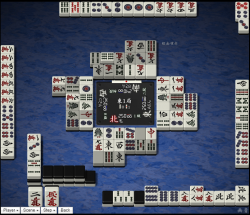Suukantsu: Difference between revisions
| Line 33: | Line 33: | ||
===Pitfalls=== | ===Pitfalls=== | ||
[[Image:Hadakabind.png|thumb|250px|right|Suukantsu tenpai with an [http://tenhou.net/0/?log=2014031007gm-0009-7447-xfcc2dd624f0d&tw=3 unescapable hadaka tanki situation].]] | |||
The difficulty of this yakuman stems from the numerous pitfalls during its hand development. | The difficulty of this yakuman stems from the numerous pitfalls during its hand development. | ||
Revision as of 22:23, 9 January 2015
| Type | Yakuman |
|---|---|
| Kanji | 四槓子 |
| English | Four kans |
| Value | Yakuman |
| Speed | Extremely slow |
| Difficulty | The most difficult |
Suukantsu 「四槓子」 is a standard yakuman, where the hand has collected kan four times. As a result, this hand always has uses a hadaka tanki machi, because four tile calls are required. Of all the hands possible, suukantsu is the rarest. Unlike all the other patterns, this yakuman cannot afford to have particular tiles unavailable via discards, the dead wall, or used in other player's hands.
Tile pattern
Viability
This yakuman requires four kan calls. As a result, the hand in tenpai always uses hadaka tanki. In order to call a single kan, a player must draw at least 3 out of 4 of a single tile type under any of these three scenarios:
- A player has a pair and calls pon. Then draws the fourth to call kan.
- A player has a closed triplet and calls kan on a discarded fourth.
- A player draws all four of a tile type and calls kan.
For this yakuman, a player must repeat any of those kan calls four times. This yakuman is the most difficult yakuman to attain tenpai, let alone score. If any of those tiles are rendered unavailable for kan, it forces the hand to seek other possible tiles to call kan with; or the hand is made virtually impossible.
Pitfalls

The difficulty of this yakuman stems from the numerous pitfalls during its hand development.
- Another player developing and winning with a faster and easier hand. This may be the case for any hand.
- The winning tile is made unavailable, which again may be the case for any hand.
- The player has called pon on a tile type, but the fourth tile was not available - either discarded earlier, drawn by another player, or in the dead wall.
- Another player has called kan. This prevents one player from calling kan four times.
- Hadaka tanki may create a perilous situation, where the last remaining tile and drawn tile are dangerous tiles.
Value
Despite the greater degree of difficulty and exceptionally low freqency, the value remains as that of the other single yakuman.
External links
- Suukantsu in Japanese Wikipedia
| |||||||||||||||||||||||||||||||
